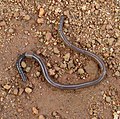Earthworm
Earthworm is a type of worm that is commonly found in soil. They are part of the phylum Annelida and the class Clitellata. Earthworms are known for their role in soil fertility and are often used in composting.
Anatomy[edit]
Earthworms have a segmented body, with each segment containing a set of organs. The body is covered by a thin cuticle, which protects the worm from the environment. The anterior end of the worm contains the mouth and the posterior end contains the anus. The digestive system of the earthworm is a straight tube that runs from the mouth to the anus. Earthworms also have a closed circulatory system, with a dorsal blood vessel that carries blood to the anterior end of the worm and a ventral blood vessel that carries blood to the posterior end.
Ecology[edit]
Earthworms play a crucial role in the ecosystem. They are known as "ecosystem engineers" because they significantly alter the physical and chemical properties of the soil. They do this by burrowing through the soil, which improves soil structure and water movement. They also consume organic matter, which they excrete as casts. These casts are rich in nutrients and help to improve soil fertility.
Reproduction[edit]
Earthworms are hermaphrodites, meaning they have both male and female reproductive organs. However, they cannot self-fertilize and must mate with another earthworm to reproduce. During mating, two earthworms align their bodies and exchange sperm. The sperm is stored in sacs until the eggs are ready to be fertilized. After fertilization, a cocoon is formed around the eggs, which is then deposited in the soil. The young earthworms emerge from the cocoon after a few weeks.
Human use[edit]
Earthworms have been used by humans for various purposes. They are often used in composting, where they help to break down organic matter and produce nutrient-rich compost. They are also used in vermiculture, the practice of breeding and raising earthworms for use in composting and as bait for fishing.
See also[edit]
References[edit]
<references />
|
|
|
-
Earthworm
-
Earthworm head
-
Annelid redone with white background
-
Earthworm nervous system
-
Earthworm setae
-
Earthworm - Tokyo area - May 6 2021
-
Mating earthworms
-
Earthworm - L. terrestris cocoons
-
Earthworm egg
-
Close up of earthworm
-
Earthworm - L. terrestris permanent vertical burrow
-
Staphylinus olens vs Lumbricus terrestris
Ad. Transform your life with W8MD's Budget GLP-1 injections from $75


W8MD offers a medical weight loss program to lose weight in Philadelphia. Our physician-supervised medical weight loss provides:
- Weight loss injections in NYC (generic and brand names):
- Zepbound / Mounjaro, Wegovy / Ozempic, Saxenda
- Most insurances accepted or discounted self-pay rates. We will obtain insurance prior authorizations if needed.
- Generic GLP1 weight loss injections from $75 for the starting dose.
- Also offer prescription weight loss medications including Phentermine, Qsymia, Diethylpropion, Contrave etc.
NYC weight loss doctor appointmentsNYC weight loss doctor appointments
Start your NYC weight loss journey today at our NYC medical weight loss and Philadelphia medical weight loss clinics.
- Call 718-946-5500 to lose weight in NYC or for medical weight loss in Philadelphia 215-676-2334.
- Tags:NYC medical weight loss, Philadelphia lose weight Zepbound NYC, Budget GLP1 weight loss injections, Wegovy Philadelphia, Wegovy NYC, Philadelphia medical weight loss, Brookly weight loss and Wegovy NYC
|
WikiMD's Wellness Encyclopedia |
| Let Food Be Thy Medicine Medicine Thy Food - Hippocrates |
Medical Disclaimer: WikiMD is not a substitute for professional medical advice. The information on WikiMD is provided as an information resource only, may be incorrect, outdated or misleading, and is not to be used or relied on for any diagnostic or treatment purposes. Please consult your health care provider before making any healthcare decisions or for guidance about a specific medical condition. WikiMD expressly disclaims responsibility, and shall have no liability, for any damages, loss, injury, or liability whatsoever suffered as a result of your reliance on the information contained in this site. By visiting this site you agree to the foregoing terms and conditions, which may from time to time be changed or supplemented by WikiMD. If you do not agree to the foregoing terms and conditions, you should not enter or use this site. See full disclaimer.
Credits:Most images are courtesy of Wikimedia commons, and templates, categories Wikipedia, licensed under CC BY SA or similar.
Translate this page: - East Asian
中文,
日本,
한국어,
South Asian
हिन्दी,
தமிழ்,
తెలుగు,
Urdu,
ಕನ್ನಡ,
Southeast Asian
Indonesian,
Vietnamese,
Thai,
မြန်မာဘာသာ,
বাংলা
European
español,
Deutsch,
français,
Greek,
português do Brasil,
polski,
română,
русский,
Nederlands,
norsk,
svenska,
suomi,
Italian
Middle Eastern & African
عربى,
Turkish,
Persian,
Hebrew,
Afrikaans,
isiZulu,
Kiswahili,
Other
Bulgarian,
Hungarian,
Czech,
Swedish,
മലയാളം,
मराठी,
ਪੰਜਾਬੀ,
ગુજરાતી,
Portuguese,
Ukrainian













